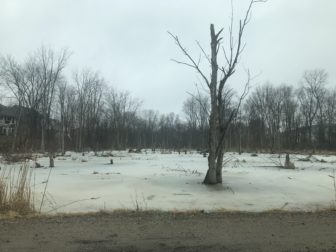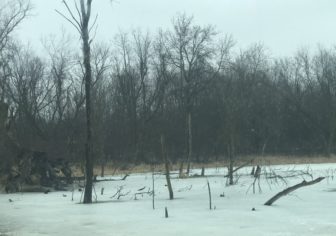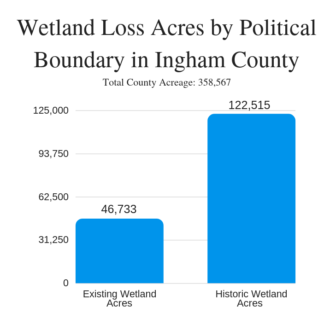
Mikayla Temple
Wetlands similar to this one can be seen all around the Meridian Township area and are considered an important part of the township.
After approval to move forward with building in December of 2018, Lafontaine Automotive Group requested a wetland use permit that would allow them to fill a .007 acre (304 square foot) wetland located at 1448 West Grand River Ave.
On Monday evening, the Meridian Township Planning Commission discussed the possible approval or disapproval for the wetland permit.
Principal Planner Peter Menser said the Township Board usually has control over the approval of wetland permits, but in this case, it was in the hands of the Planning Commission.
“The way that the permits work is, whatever land use decision is being made, in this case there was a special use permit for the new car dealership that was decided by the Planning Commission only, it did not go onto the Township Board,” he said. “So, in this case, any related wetland use permit would be decided by the Planning Commission.”
And in this case, the special use permit is different from those that residents in the township may have seen before. The permit that LaFontaine had to request is called a joint permit meaning it isn’t a township application, but instead is used for both the Michigan Department of Environmental Quality and the U.S. Army Corps of Engineers. While the application may look different, the process still remains the same.
LaFontaine completed the first step of identifying the existing wetland boundaries in June of 2018. Marx Wetlands conducted the research and concluded that it’s a regulated wetland because of its close proximity to a pond across the street. Because it is considered a regulated wetland, getting rid of it completely wasn’t an option for the new car dealership.

Mikayla Temple
The Planning Commission said the regulated wetlands are too important to get rid of. So, LaFontaine will have to compensate for the destroyed wetland if the permit is approved.
Project applicant and owner Gary Laundroche said when designing the layout of the future dealership, he tried to think of any way to leave the wetland and to use it as an asset to show trucks and SUV outside on the parking lot.
However, he found keeping the wetland couldn’t be possible due to the requirement of having a seven-foot-long sidewalk across the length of the development. Laundroche also said he tried designing the sidewalk to go around the wetland, but it would pose a dangerous threat to people being so close to the steep wetland.
Prior to submitting the wetland use permit, the current wetland was being threatened with destruction. A new and improved county water drain will be going in the pond across the street. The water main would run from the neighboring water area to the middle of the wetland causing it to be destroyed.
Menser said because the conclusion of the boundary lines indicated the wetland to be regulated, filling it could only be an option if the applicant would put in another wetland larger than the previous one.
“Because they’re eliminating one wetland, the township requires mitigation so they have to create new wetland 1.5 times greater than the original size on another site on the property,” he said.
The new wetland mitigation would also require ongoing monitoring requiring Laundroche to submit reports saying the mitigation is working and the wetland isn’t being taken over by invasive species. The township will not lose money in the monitoring process because it will collect financial insurance.
Laundroche said he fully supports adding in a new wetland and sees it as a benefit to the people.
“On one hand, we think it’s an improvement and that it does serve the public, in this case, because what we’re creating is a much nicer, regulated, larger wetland in the rear of the site,” he said.
If the wetland use permit is approved, the new wetland on the LaFontaine property would be a maximum of five feet and will be designed with a fore bay draining to the east so it won’t be full at all times or disturb the neighboring houses to the west of the property.
“I think it really turns out to be a win-win,” Laundroche said.
Chairman of the planning commission, John Scott-Craig, said he sees this ending positively since wetlands play a huge role in the township.
“This is the end of the line for this,” he said. “This is our decision, and I think it’s important. I mean wetlands are an important part of our township.”

Figure 1 The wetland loss over the years according to the Status and Trends report from the Department of Environmental Equality is -62% so preserving the ones left or adding larger ones to the township is important to keep this number growing again.
The commission unanimously voted to bring the wetland use permit request back for a resolution proposal at the next meeting on March 25.